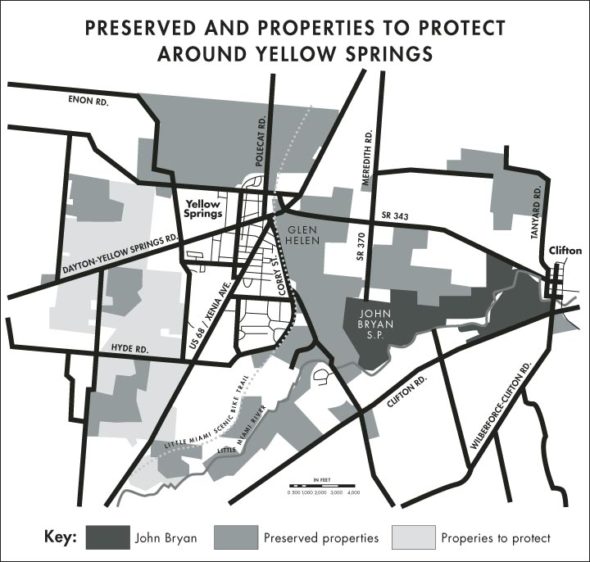Tecumseh Land Trust to host resource fair
- Published: November 8, 2018
Land and water preservation and management, soil conservation and other environmental matters will be explored at the Landowner Resource Fair hosted by the Tecumseh Land Trust this weekend.
The event is Saturday, Nov. 3, at the John Bryan Community Center, 100 Dayton St. It is free and open to the public.
The resource fair will be the first of its type hosted by TLT, which serves as a one-stop information resource for the many government and nonprofit programs in place to conserve land and water resources on area properties.
According to Krista Magaw, executive director of Tecumseh Land Trust, the focus of the event is on educating landowners, large and small.
“There’s a community education aspect about what we do,” Magaw said this week. “[We’re] showing why conservation is important, why smart land use is important.”
Sessions on estate planning and conservation easements will be mixed with presentations on prairies, pollinator plantings, cover crops, soil building and converting to organic agriculture.
One thrust of the event is to encourage landowners in the Jacoby Creek watershed just west of Yellow Springs to permanently preserve their properties through conservation easements held by TLT.
The Village of Yellow Springs has long reaffirmed the need to protect the rural landscape and prime soil of the Jacoby watershed from eastward commercial and residential expansion from the direction of Fairborn. The goal of creating a Jacoby Greenbelt dates back to the 1970 Village Comprehensive Land Use Plan.
Those plans took a step forward last year when TLT won a $1.44 million grant over the next five years to purchase agricultural easements, fund conservation practices and conduct other programs in a part of the Little Miami watershed.
The Jacoby Partnership, which mobilizes part of the 2014 Farm Bill, is one of only 70 such programs approved nationwide. An additional $2.1 million of state and local funds have been earmarked for the project. The Village of Yellow Springs has committed up to $205,000 from its greenbelt fund.
The first session at Saturday’s Landowner Resource Fair, at 11 a.m., will cover the Jacoby Partnership and is intended specifically for landowners of properties in the Jacoby Greenbelt.
With a conservation easement, a landowner deeds certain rights and oversight to the trust, to ensure the land will be protected from overdevelopment or practices that endanger the environment.
“We work with landowners who do want to put some permanent restrictions on their land,” Magaw explained. “The conservation easement is the tool that we use to do that.”
As a legal deed, it will show up in title searches in the future to ensure compliance. The easement process may take months or even years, but “we’ll do the complicated stuff” Magaw assures potential participants.
Established in 1990, TLT has grown to protect 26,700 acres of land in Clark and Greene counties with 157 conservation easements. There are about 1,400 land trusts across the country, and about 30 in Ohio.
Farming practices eyed
Other sessions at Saturday’s Landowner Resource Fair will address a variety of specific conservation and farming practices the TLT supports as part of its mission.
At 12:30 p.m., which is also when information areas open to the public, Emily Archibald will discuss “Prairies and Pollinator Plantings.” The session will focus on how landowners, large and small, can start their own wildlife areas with native plants that encourage wildlife habitat, reduce soil erosion and foster monarch butterflies and other pollinators, according to Magaw. Archibald, an ODNR private lands biologist for Ohio Wildlife District Five.
David Brandt, a farmer from Fairfield County, will share his experience with “Cover Crops and Soils” at the 1:30 p.m. session. Brandt uses exclusively no-till practices and a wide variety of cover crops, and is considered an expert in the field. He has spent over 15 years documenting his success using cover crops such as beets or ryegrass to minimize erosion, retain moisture and add organic matter and nutrients to soil.
Brandt will discuss how off-season planting of cover crops can also be used by backyard gardeners to enrich their soil and make as much use as possible of the growing year and sunlight hours in order to add life to the soil, according to Magaw.
Then, at 2:30 p.m., Julia Barton will speak on “Converting to Organic.” Barton is a sustainable agriculture educator with the Ohio Ecological Food and Farm Association.
According to Magaw, whether someone is a backyard gardener or a farming professional, organic practices offer numerous benefits not only for the crops themselves, but also for environmental and conservation considerations, too.
Ohio State University Associate Professor Chris Bruynis will discuss “Farm Transition and Succession Planning” at 3:30 p.m. Bruynis is an authority on the financial side of farming, including taxes and estate planning, as well as how a conservation easement may benefit landowners now and for generations to come. Closing discussions and Q&A will continue until 5 p.m.
In addition to the presentations, representatives from a variety of partner organizations will be on hand to provide information and resources, including The Nature Conservancy, Greene County Soil and Water Conservation District, The Natural Resource Conservation Service, Ohio EPA, Village of Yellow Springs, The Arthur Morgan Institute for Community Solutions, Clean Ohio Agricultural Easement Purchase (ODA), Open Space (OPWC) Programs and others.
Registration is not required, but appreciated for planning purposes. Call 767-9490 or email sunflower@Tecumsehlandtrust.org with questions or to RSVP.
The Yellow Springs News encourages respectful discussion of this article.
You must login to post a comment.
Don't have a login? Register for a free YSNews.com account.














No comments yet for this article.